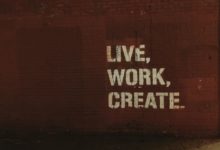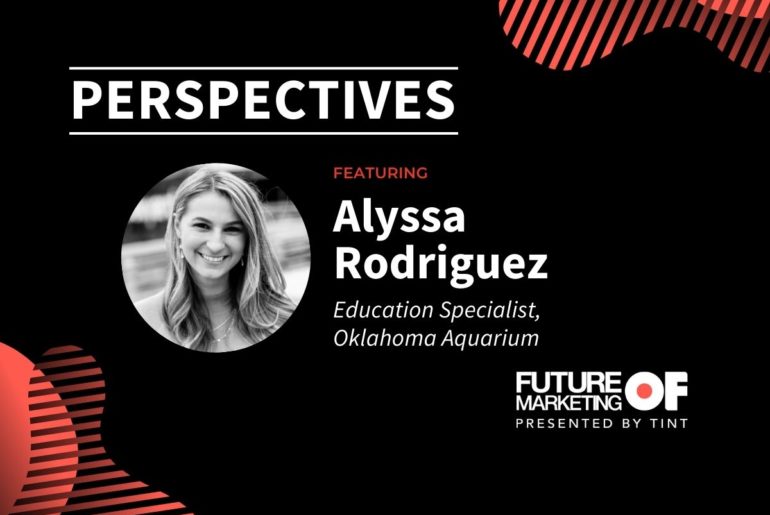Perspectives is a series uncovering routines, inspiration, and insights by brand leaders shaping the future of marketing around the globe.
EDITOR’S NOTE: Christine Johnson is the Digital Marketing Specialist at Vancouver Island University. In her words, Christine shares her perspective on:
- Her experience pivoting in Higher Ed during a pandemic
- The importance of community-building (and Twitter’s potential)
- Why accessibility in marketing matters
What do you do for a living? What does your typical day look like?
I work at Vancouver Island University. I’m their Digital Marketing Specialist, and I focus on domestic markets to recruit students and market our university.
The day-to-day can be pretty different.
We have 120 programs, 22 graduate programs, 16 trades, and 84 undergraduate programs – and I work a little bit with all of them. I have a marketing team that I work quite closely with; we’ve got a number of graphic designers, a videographer, we’ve got communications officers, and I also have a dotted line relationship to the web team, so a little bit of I.T. as well; I’m quite involved with the website.
How do you manage all of that?
I basically coordinate and collaborate with everyone, and oversee bigger campaigns. If we have a campaign that needs a couple of graphics, a video, and an event, I’ll touch base with the people involved, who would be in charge of that, and then help facilitate from that side.
What blogs, sites, sources do you follow for marketing news and insights?
I’m suddenly really obsessed with Twitter, which I’d never thought would happen – but we’ve all developed new hobbies over the past year, and Twitter is one of them. I find that it’s been a great community.
When I first started out in marketing, I was obsessively reading all kinds of blog posts, like SEMrush and Moz – and very SEO-focused when I initially started about eight years ago, but since then, I kind of enjoy finding inspiration from the campaigns and the material that I see out – like online. This might not always be targeted towards me, but I’m always trying to keep a lookout for what my competitors are doing. Although, they’re not really competitors – when you’re in higher ed, it’s another school and you coordinate and work together, but they are sometimes competitors. And I’m curious to know what they’re doing or how they’re shifting, and that’s sort of how I’ve kept my hand on the pulse so to speak.
What did pivoting in Higher Ed look like?
Well, the first few days for me, I really struggled because I had to turn everything off. Anything that was scheduled, any paid media that I had going out, any events that we were going to launch in a few weeks all kind of went [out the window].
So that was very logical, but it was really hard. Then, we had to regroup a little bit and think about what’s next… What do we do now? How do we continue to reach out to and support students in a way that is on brand, hits the right tone, and for a young audience?
Around this time last year, I remember there were all these really big companies – and I’m not alone in this feeling – that were releasing commercials that were very nice, but they all sounded and looked the same… and maybe after a little while, it felt a bit inauthentic. So, we were quite nervous to go out with any sort of messaging that was: a) insensitive, b) inaccurate, and c) inauthentic – because we did still want to be that source of support for students. It was hard to wrap my head around, but I think we got there and it didn’t happen overnight. It was a process and we learned a lot from it.
Some of the biggest changes and pivots were focusing, instead of in-person events, pulling it to videos or online events – that was one of the biggest ones. We moved away from some of our print media into more digital channels – and some of that worked, and some of that we’re assessing how that worked and if we should go back and maybe offer both now… both the digital and the print version of a product that might have only been printed before.
What is something interesting or surprising you learned in the last few months?
You have to be okay with having two plans.
Sometimes as a marketer, you get a creative idea and you love it, and you want to run with it, and you think it’s the most amazing thing, and you have this vision, but what I learned is that you have to be okay with letting that go and move onto something that’s more current and impactful for the situation.
What should everyone in the social marketing space STOP doing?
I don’t love the growth hacking things that I see sometimes.
They’re not really conversation starters, and I don’t know that they provide a lot of value. I think they’re fun – you tag all your friends, you share it, you post it, everybody likes it.
I’m not really good at Twitter in the sense that I never stay within the character limit with what I want to say – but sometimes that sparks a conversation, or sometimes someone will add [their thoughts], and I’ll learn from whatever they’re sharing. That’s way more fun and something that I enjoy a lot more for social media.
What should everyone in the social marketing space START doing?
Investing their time and energy into communities that align with what they’re trying to learn about, or where they’re trying to grow.
For me, that was a big learning curve, because like I said before, I wasn’t on Twitter – I didn’t really get it. I didn’t have any friends or anyone that I knew personally who was on Twitter, so I just didn’t have any reason.
You can set up a couple of tweets, but you don’t really get it unless you spend a bit of time there. But what happened for me is that I took an online course and they said, “Everyone get on Twitter. We’re going to share and support each other through this platform.” So I did.
Then, I found another community – and I was like, Oh, now I get it. This is how people are connecting. And then they’re connecting with each other and recommending each other… And it kind of grew from there.
For me, I was feeling a bit weird about social media… I was feeling a bit like I don’t want to do this anymore.
I remember 10 years ago, it was so fun and everything was new, new features would come out, and it’d be really exciting. But the past few years, I liked the new platforms, I played around with them, and they’re great and everything, but it just hasn’t felt like I want to hang out here, meet people, and talk to others. Whereas, with this new sort of Twitter hobby that I’ve taken up… I’ve really changed in that sense. It’s been a big shift for me.
Why do you think user-generated content (UGC) is so valuable for brands?
I love that we’re able to bring the customers’ voices, or the students’ voices into our material – and that’s where I think it became way more impactful because it goes from being just like, an overview video about who we are and what we offer to their experiences, what they like, what they do, where they hang out, why they might have chosen the school, how it’s impacted them little hints and tips that I might not think to promote as the marketer… but as the student, whoa, I can’t write that stuff.
Did you see a difference in engagement when you featured your students in your content?
Yes, for sure.
A couple of really cool things happened. [A video we shared] got a lot more views – we did share it out a lot more – but at one of our virtual events, someone actually joined and attended, and they said, “I’m really excited to meet you guys because I’ve been watching the video, and you’re part of the reason why I want to come to school here.”
What do you feel most marketers struggle with? How can we fix this?
It’s the battle for attention.
I feel like one struggle is figuring out what channel works for your business or organization. Every now and then something kind of dramatic comes out – like email is dead or search engine optimization is dead… I don’t think anything is dead.
I’m probably going to make a purchase this weekend from a piece of direct mail that I got in my mail, so that’s not dead either. People are still buying, it’s still working. You just have to figure out what’s working for your audience and where your customers are spending time.
How did virtual events work out for you?
We had a little bit of fun with it, and we made some nice videos. It was a really big change and a big pivot – and the hardest part was that there’s so much tradition tied to graduation. It’s quite emotional and impactful for the students and maybe their parents, or their teachers – it’s a big deal. So to not be able to offer that in-person experience, I think a lot of my colleagues really felt that… But we did it and we put together something really fun that they got to enjoy.
I mean, it wasn’t in-person, it was all online – but they had their moment where they got acknowledged for so many years, tears, and so much hard work.
I don’t know what it looks like when we’ll be able to go back to in-person events – but maybe a shift that will come of this is that we’ll have an in-person option and maybe an online option. The conversation is always evolving but I think for what we offered, I’m really happy with what we did. But part of me always wishes that we could have still had everyone in person to congratulate them.
What does the future of marketing look like to you?
I think we’re going to see some new channels and trends emerge. Audio seems to be on a lot of people’s radar… how much of a trend that becomes, I’m still on the fence with it. I’m not totally sold that it’s here forever.
It’s lots of fun, but a big thing with audio is that you have to be kind of in a quiet space. And I don’t know if that really kind of works on the go – like I can’t just check my messages really quick and give it a “like. “
But I’m noticing that a lot of companies and organizations are way more focused on authenticity and being empathetic – and I don’t think that’s a trend that’s going to go away.
How can brands and teams prepare? How can brands be more authentic and empathetic?
Some of my colleagues are taking one-day training courses or just learning about it in their own time. The conversation is happening… It’s been talked about a lot, and I think that’s a big part of the shift.
It’s just about making an effort, and being a bit more conscious about what your audience and customers need. Try talking to your customers a little bit more – it doesn’t have to be all via email or text message. You could pick up the phone, sometimes that works.
What is a book, podcast, person, or event that helped shape your career? Why?
I was always really attracted to the field because of the creative elements. And then, as it evolved, it became a bit more technical – I liked learning the emerging technologies and that side of things.
Who, where, or what do you look to for inspiration?
I try to put myself in the shoes of someone who’s considering either going back to school or maybe they’re just at the tail end of high school – and we know that they’re spending more time on certain channels than others.
If you’re in high school, maybe you’re not on Facebook, except for your mom and dad hanging out, so maybe you’re on TikTok… What’s happening there? What’s trending there? What’s happening on Instagram?
There are lots of research papers that come out periodically that I read through to try to get a better sense of other trends that other schools are seeing.
What advice do you have for marketers and creatives who look up to you?
Always stay creative and don’t be afraid to reach out to people.
For me, personally, a lot of people have been very generous with their time – whether it’s setting up a call or reaching out via direct message. There are no dumb questions, people will know that you’re young, and you’re starting out, and you’re eager to learn… so don’t be afraid to lean into that, connect, and enjoy the process.
How do you wind down from a long day of work?
I’ve been trying to run a little bit more, which isn’t always very easy to do when you’re feeling kind of tired and you’ve been sitting for most of the day.
It’s kind of dorky to say I want to get my steps in, but if that’s what keeps you motivated, then that’s what keeps you motivated. So, that’s what I’ve been doing.
What are you excited about or looking forward to?
I’ve been doing my best to learn about accessibility over the past few months.
There are a few reasons why it came up. Our campus is located on a hill, so from an accessibility standpoint, there are some improvements that we’re trying to make so that it’s easier for people to get around. But that conversation led me to web accessibility, which I talk about a little bit on Twitter. I try to share tips that I’m learning every week. It’s been really helpful to understand the needs of my audience better and use better practices to make material that’s more impactful for everybody. It’s that sort of inclusion piece, accessibility piece.
I’m excited about it because it’s a learning piece. It’s something that started off as just a regular conversation amongst my team that we’re talking about all the time… what’s going on with the accessibility project? Now there’s a web accessibility project, what’s happening with that?
Eventually, after one of my colleagues was really championing it, I figured I should start writing some of this stuff down because it’s really smart. And I’m getting it, but I want to share what I’m learning, also reinforce it for myself, and try to carry it out a little bit more in my work.
If you’re visually impaired – and you use a screen reader to actually read out the tweet or the text or whatever it is – it’s easier for that screen reader to understand the cue. It’s meant to be like an influx and how they pronounce it. And then, as a normal reader, I find it way easier visually (for me) to understand that you have four words together. But also, if maybe you have dyslexia, it’s much easier for you to understand the hashtag as well, for example.
Don’t miss out on weekly insights and future interviews with marketing leaders. Subscribe here.




